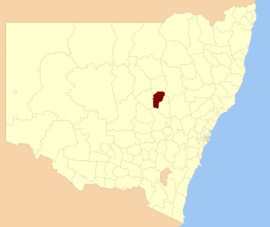City of Dubbo
| City of Dubbo New South Wales | |||||||||||||||
|---|---|---|---|---|---|---|---|---|---|---|---|---|---|---|---|
 Location in New South Wales | |||||||||||||||
| Coordinates | 32°15′S 148°36′E / 32.250°S 148.600°E | ||||||||||||||
| Population | 41,211 (2011)[1] | ||||||||||||||
| • Density | 12.0324/km2 (31.164/sq mi) | ||||||||||||||
| Established | 1872 | ||||||||||||||
| Area | 3,425 km2 (1,322.4 sq mi) | ||||||||||||||
| Council seat | Dubbo | ||||||||||||||
| Region | Orana | ||||||||||||||
| State electorate(s) | Dubbo | ||||||||||||||
| Federal division(s) | Parkes | ||||||||||||||
| Website | City of Dubbo | ||||||||||||||
| |||||||||||||||
The City of Dubbo is a local government area in the Orana region of New South Wales, Australia. The area is located adjacent to the Mitchell, Newell, and the Golden highways, the Main Western railway line, and the Macquarie River.
The largest population centre is the regional city of Dubbo. The local government area also includes the villages of Eumungerie, Mogriguy, Brocklehurst, Wongarbon, Toongi, and Rawsonville.[2]
The Mayor of the City of Dubbo Council is Cr. Mathew Dickerson, an independent politician.
History
The Dubbo local government area came into being on 19 February 1872, when the Municipal District of Dubbo was approved by the Colonial Secretary. The first six aldermen were elected into office on 22 April 1872 with 82 votes being cast for a wide field of candidates.[3]
Talbragar Shire was amalgamated with the Dubbo City Council on 1 April 1980. At that time the area of the city was 3,321 square kilometres (1,282 sq mi); and with a population estimated at 29,000.[3]
Proposed amalgamation
A 2015 review of local government boundaries recommended that the City of Dubbo merge with the Wellington Council to form a new council with an area of 7,536 square kilometres (2,910 sq mi) and support a population of approximately 51,000.[4] The outcome of the independent review is expected to be completed by mid–2016.
Council
Current composition and election method
Dubbo City Council is composed of eleven Councillors elected proportionally as a single ward. All Councillors are elected for a fixed four-year term of office. The Mayor is elected by the Councillors at the first meeting of the Council. The most recent election was held on 8 September 2012, and the makeup of the Council is as follows:[5]
| Party | Councillors | |
|---|---|---|
| Template:Australian politics/party colours/Independent| | Independents and Unaligned | 11 |
| Total | 11 | |
The current Council, elected in 2012, in order of election, is:[5]
| Councillor | Party | Notes | |
|---|---|---|---|
| Template:Australian politics/party colours/Independent| | Ben Shields | Unaligned | Deputy Mayor[6] |
| Template:Australian politics/party colours/Independent| | Mathew Dickerson | Independent | Mayor[6] |
| Template:Australian politics/party colours/Independent| | John Walkom | Unaligned | |
| Template:Australian politics/party colours/Independent| | Bill Kelly | Independent | |
| Template:Australian politics/party colours/Independent| | Greg Mohr | Unaligned | Elected on Ben Shields ticket |
| Template:Australian politics/party colours/Independent| | Allan Smith | Independent | |
| Template:Australian politics/party colours/Independent| | Kevin Parker | Unaligned | |
| Template:Australian politics/party colours/Independent| | Tina Reynolds | Independent | |
| Template:Australian politics/party colours/Independent| | Greg Mathews | Unaligned | |
| Template:Australian politics/party colours/Independent| | Lyn Griffiths | Independent | |
| Template:Australian politics/party colours/Independent| | Rod Towney | Independent | |
The Dubbo City Council staffs around 350 permanent employees, and is responsible for the city and surrounding areas. The Civic Administration Building is located on the corner of Darling and Church Streets and now has a "One Stop Shop" for all customers of the council.
Industrie
As a regional centre, the City of Dubbo provides services far beyond its own population base. It serves 130,000 people, and one third of the geographic area of New South Wales.[2] The main industry sectors represented in the City of Dubbo are retail, health, manufacturing, transport, tourism, education, construction, business services, agriculture, and government services.[2]
Sister cities
The City of Dubbo has four sister cities:[7]
 Minokamo, Japan, since 1989.
Minokamo, Japan, since 1989. Warringah, New South Wales, since 1994.
Warringah, New South Wales, since 1994. Wujiang, China, since 1995.
Wujiang, China, since 1995. Newcastle, New South Wales, since 1995.
Newcastle, New South Wales, since 1995.
References
- ^ Australian Bureau of Statistics (31 October 2012). "Dubbo (C)". 2011 Census QuickStats. Retrieved 24 October 2012.
- ^ a b c "Annual report: 2004-2005" (PDF). Dubbo City Council. 2005. Retrieved 11 November 2006.
- ^ a b "History of Dubbo City Council". Dubbo City Council. Retrieved 11 November 2006.
- ^ "Merger proposal: Dubbo City Council, Wellington Council" (PDF). Government of New South Wales. January 2016. p. 7. Retrieved 4 March 2016.
- ^ a b "Dubbo City Council: Summary of First Preference Votes for each Candidate". Local Government Elections 2012. Electoral Commission of New South Wales. 16 September 2012. Retrieved 24 October 2012.
- ^ a b van de Wetering, Jodie (25 September 2012). "Check your new council details". ABC Western Plains. Australia. Retrieved 24 October 2012.
- ^ Dubbo Sister Cities
External links
![]() Media related to City of Dubbo at Wikimedia Commons
Media related to City of Dubbo at Wikimedia Commons
